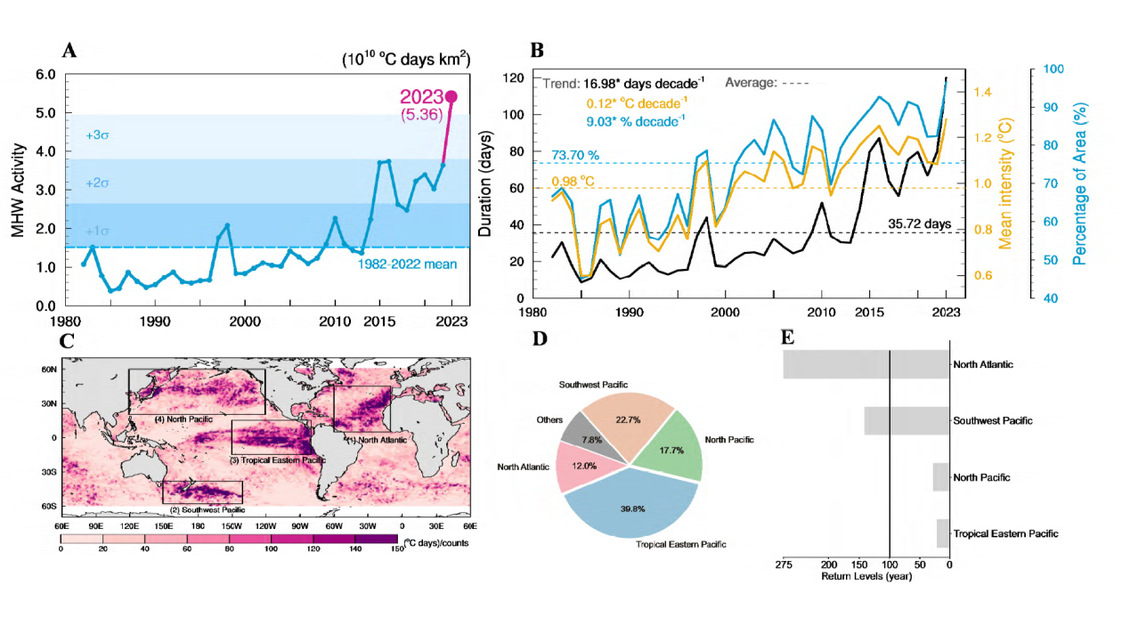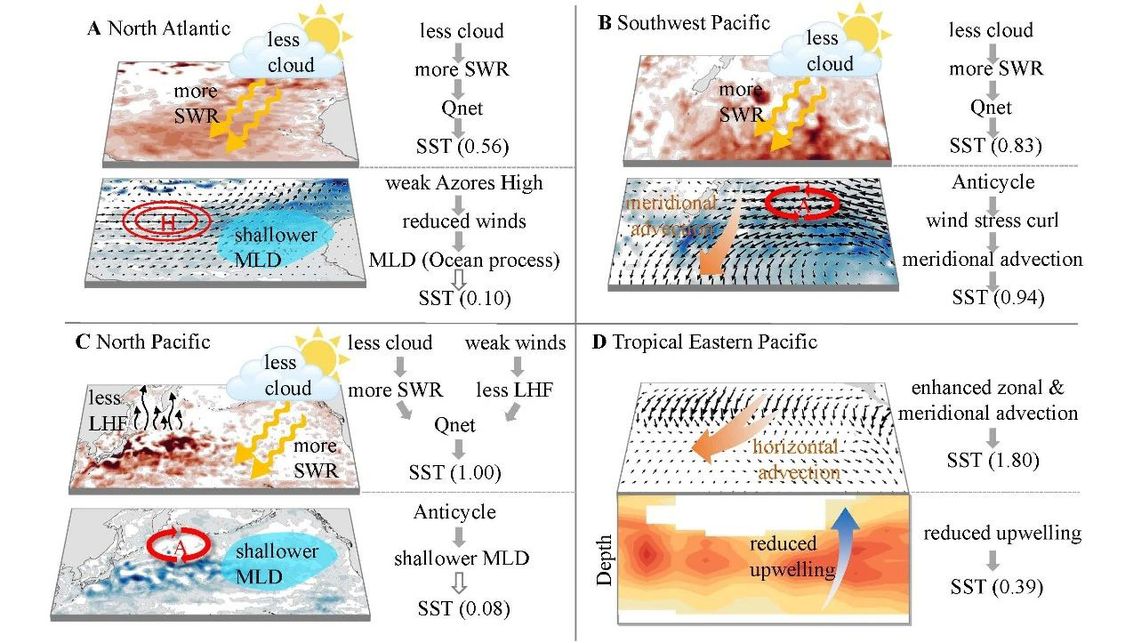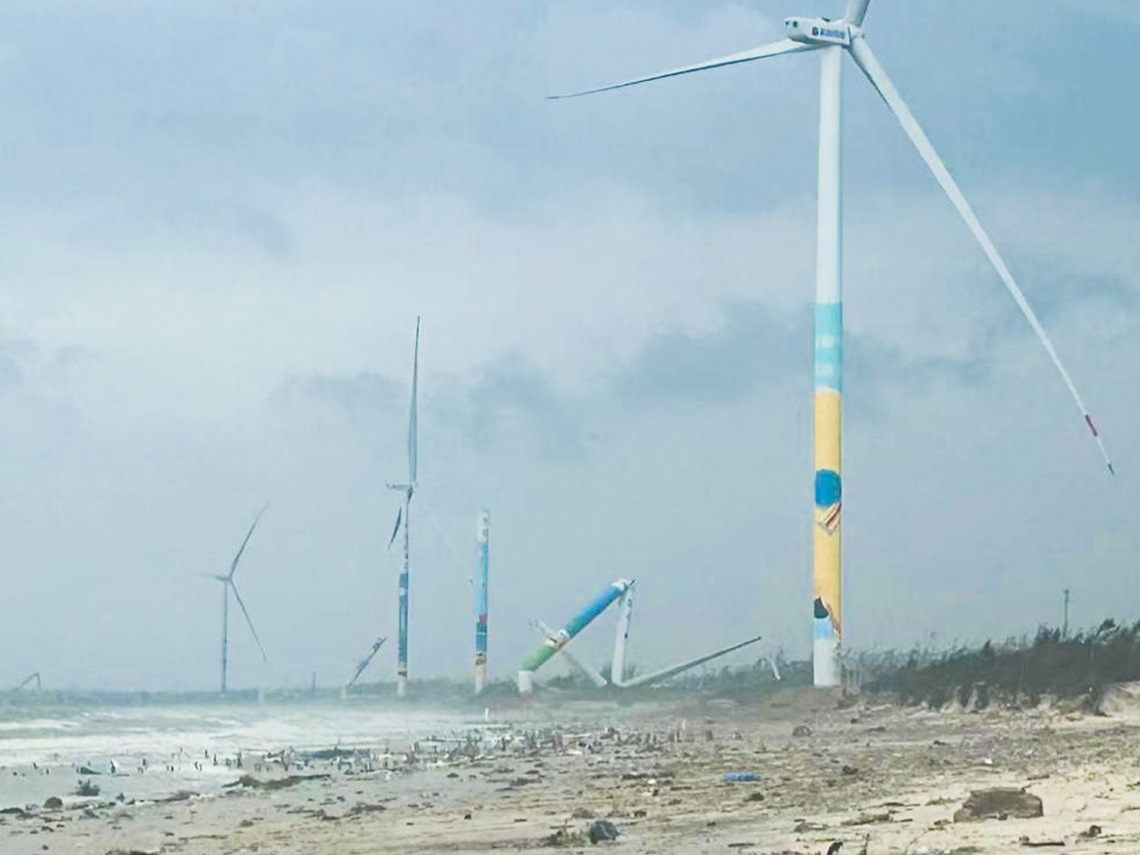The results indicate that the concurrent outbreak of MHW events in multiple regions in 2023 reflects significant and complex changes within the climate system. The study further reveals notable differences in the formation mechanisms of MHWs across different global regions, providing crucial scientific evidence for understanding and predicting future extreme ocean events. Advancing Earth System Science is paramount for uncovering the intrinsic mechanisms of such complex climate phenomena, improving global climate prediction capabilities, and formulating scientific mitigation strategies. By integrating data from multiple spheres—the atmosphere, ocean, land, and biosphere—it provides a solid scientific foundation for addressing global warming and extreme climate events.
A Once-in-a-Century Event: Global Marine Heatwave Intensity Shatters Historical Records
2023 was confirmed by the World Meteorological Organization (WMO) as the warmest year on record, with both global sea surface temperature (SST) and ocean heat content (OHC) reaching record highs. The European Centre for Medium-Range Weather Forecasts (ECMWF) and the UK Met Office noted that the North Atlantic SST in June 2023 was about 1.3 °C above average. Director of NASA climate Gavin Schmidt further stated, There is an urgent need to determine why 2023 might have been the warmest year in the past 100,000 years.

Figure 1. Record-breaking total MHW intensity in 2023, with several key regions far exceeding once-in-a-century extreme levels.
Against the backdrop of anomalous global ocean warming, extreme MHWs became a focal point of climate research, attracting significant international attention regarding their formation mechanisms and potential impacts. The latest research by Professor Dongxiao Zhang's team from Eastern Institute of Technology, Ningbo, published in Science, shows that the total cumulative MHW intensity in 2023 reached 5.36×1010 ℃ days km2, exceeding three standard deviations above the climatological mean and setting the most extreme annual level on record. Specifically, the North Atlantic and the Southwest Pacific experienced extreme events estimated to occur once every 276 years and 141 years, respectively, far surpassing historical counterparts in intensity and duration. Globally, the average duration of MHWs in 2023 was 120 days, extending up to 525 days at maximum, with an average intensity of 1.3°C. The area affected by MHWs exceeded 96%, significantly higher than the average over the past 40 years.
Tracing the Roots: What Caused the "High Fever" in Four Key Ocean Basins?
Why did the ocean sustain a “high fever”? Were the “causes” the same across different regions?
To deeply uncover the physical mechanisms behind the 2023 MHWs, the research team utilized daily, full-depth, high-resolution data from the ECCO2 ocean state estimate to conduct a mixed-layer heat budget analysis. They quantified the relative contributions of thermodynamic and dynamic processes—such as shortwave radiation, mixed-layer variability, ocean advection, and upwelling—in different regions, clarifying for the first time the distinct driving mechanisms in four key global ocean regions.

Figure 2. Schematic diagram of the driving mechanisms for the 2023 marine heatwaves.
North Atlantic: An anomalously weakened subtropical high led to reduced cloud cover and a shallower mixed layer. Enhanced shortwave radiation and zonal advection provided the energy sustaining the MHW development.
Southwest Pacific: An atmospheric anticyclone in this region caused strengthened easterlies and weakened westerlies, enhancing meridional ocean heat transport. Concurrently, reduced cloud cover allowed more solar radiation into the ocean, exacerbating sea surface warming.
North Pacific: The combined effects of enhanced shortwave radiation and reduced latent heat loss, superimposed on a shallower mixed layer, led to rapid sea surface warming.
Tropical Eastern Pacific: Changes in meridional and zonal advection and upwelling, driven by El Niño, collectively intensified ocean warming in this region.
An "Early Warning Signal" for Tipping Points in the Earth's Climate System
The research team proposes that global warming is intensifying the coupled nonlinear processes of the ocean-atmosphere system, and MHWs may now serve as crucial “early warning signals” for approaching tipping points within the Earth's climate system. The record-breaking spatial coverage, intensity, and duration of the 2023 MHWs are likely to have profound impacts on the frequency and intensity of extreme weather events, ocean carbon sink capacity, fisheries resource distribution, and coral reef ecosystems. The deepening development of Earth System Science enables a better understanding of the interactions among these nonlinear processes, providing a scientific basis for global climate governance, marine ecosystem protection, and sustainable fisheries management, thereby effectively addressing the broad challenges posed by climate change. Looking ahead, building physically-based forecasting systems, strengthening real-time multi-parameter ocean monitoring, and deepening research on early warning for extreme climate events hold significant practical importance for managing future climate risks.
Eastern Institute of Technology, Ninbgo is the first affiliation of this paper. The study was completed jointly with the Southern University of Science and Technology, Tsinghua University, the Institute of Atmospheric Physics (Chinese Academy of Sciences), Nanjing University of Information Science and Technology, University of California San Diego, Lawrence Berkeley National Laboratory, The Hong Kong Polytechnic University, Sorbonne University, and Kasetsart University, among others.
Postdoctoral researcher Tianyun Dong of Eastern Institute of Technology, Ningbo is the first author. Professor Zhenzhong Zeng of the Southern University of Science and Technology is the corresponding author. Co-authors include Academician Dongxiao Zhang (Eastern Institute of Technology, Ningbo), Academician Deliang Chen (Tsinghua University), Professor Ming Pan (University of California San Diego), Assistant Professor Yuntian Chen (Eastern Institute of Technology, Ningbo), Professor Zhaoxin Li (Sorbonne University), Researcher Tianjun Zhou (the Institute of Atmospheric Physics, Chinses Academy of Sciences), Researcher Dongzhi Zhao (Nanjing University of Information Science and Technology), Professor Alan D. Ziegler (Kasetsart University), Associate Researcher Shuxin Luo (Ningbo Institute of Digital Twin), Postdoctoral Researcher Shuai Yang (Lawrence Berkeley National Laboratory), Research Assistant Professor Dashan Wang and graduate students Lili Liang, Yubin Jin, Shijing Liang, and Xiaowen Huang (all from Southern University of Science and Technology).
This research was supported by the National Natural Science Foundation of China (NSFC) International Cooperation and Exchange Program, NSFC General Program, the China Meteorological Administration Climate Change Special Program, the Guangdong Basic and Applied Basic Research Foundation, Shenzhen Science and Technology Project for Sustainable Development in Special Innovation, the start-up and high-level special funds provided by the Southern University of Science and Technology.













